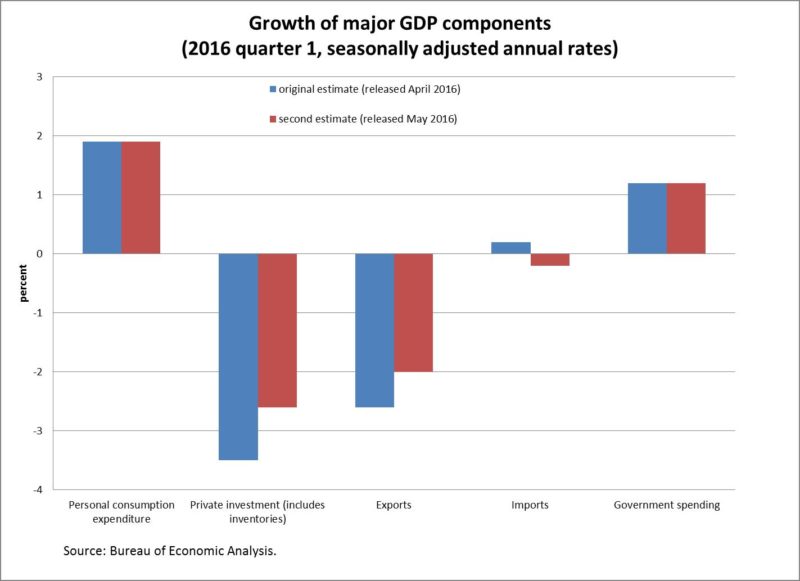A Winter of Less Discontent Than We Originally Thought
New data out this morning show it appears that the economy’s slowdown earlier this year was not as drastic as we initially concluded.
This morning, the Bureau of Economic Analysis released the revised estimates of the gross domestic product, the broadest measure of economy’s output, for the first quarter of 2016. According to the revised data, the GDP rose 0.8 percent (annual rate) in the first quarter of 2016, somewhat faster than the 0.5 percent rate indicated by the initial estimate a month ago. In the final quarter of 2015, GDP grew 1.4 percent. These estimates may yet change again when the final estimates of GDP are released next month.
The revisions were modest:

But the details provide some reassurance about the state of the economy, which has given us reason for concern in recent months.
Economic growth remains primarily driven by consumer spending, which rose 1.9 percent (annual rate) in the first quarter. Consumer spending is likely to remain strong in the near future. Today’s data release shows that disposable personal income posted a 4 percent increase in the first quarter of 2016, up from the 2.9 percent increase reported earlier. This is a faster pace of growth than at any time in 2015. A healthy growth in disposable income, which represents the fund people have available after all taxes have been paid and transfers, if any, received, makes the continued growth in consumption expenditures possible, suggesting that economic growth will continue.
Gross private domestic investment – which includes business investment and residential construction– performed a bit better than the original estimate indicated. The revised estimate still shows a decline of 2.6 percent (annual rate), but this decline is milder than the 3.5 percent drop reported earlier. The improvement came primarily from the faster growth in residential investment (housing), which rose 17.1 percent, faster than the 14.8 percent increase reported earlier. Business investment, on the other hand has shrunk 6.2 percent in the first quarter. If business investment returns to growth in the future, we should see significant improvements in the overall GDP numbers.
Net exports also showed a small improvement compared to the initial estimate. Exports shrunk a bit less: In the first quarter they fell 2 percent instead of the previously reported 2.6 percent. Imports, which are subtracted from GDP, fell 0.2 percent according to the new data, instead of the previously reported increase of 0.2 percent. As a result, net exports subtracted only 0.2 percentage points from GDP growth, while in the earlier report it subtracted 0.3 percent. Net exports are restrained by the strengthening U.S. dollar, which makes U.S.-made products more expensive for foreign buyers. The strength of the dollar is likely to continue in the near future, which suggests that the growth in net exports will remain subdued.
Click here to sign up for the Daily Economy weekly digest!








